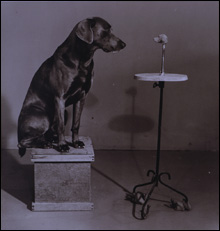
William Wegman, Man Ray Contemplating the Bust of Man Ray |
You can find a series of early William Wegman videos on YouTube; identified as having been compiled in 1972, they are grainy black-and-white mini-musings on watching and being watched, featuring two, and then one, of the artist’s very focused pet Weimaraners. The one is, I presume, the famous Man Ray, the deadpan dog and unflappable comic genius who would become Wegman’s most famous subject. In the segment “Used Car Salesman,” a shaggy-haired young Wegman sits in a swivel chair struggling to balance the 80-pound dog on his lap while trying to persuade viewers to buy a “quality” new or used car from him. The mild absurdity of the scene is typical of the tone Wegman strikes in his early experiments with the then brand new media of video, experiments that resulted in pioneering work that included visual puns, disconnects between image and language, and gentle jabs at viewers and their expectations. This work paved the way for Wegman’s large-scale color Polaroid portraits of Man Ray from the late 1970s and early 1980s, and his later work with successor Weimaraner Fay Wray, who became known and loved by audiences of Sesame Street.
“William Wegman: Funney/Strange,” guest-curated by Trevor Fairbrother and opening at the Addison Gallery of American Art April 7, includes more than 200 of the artist’s engaging paintings, drawings, videos, photographs, collages, and artist books. Wegman has moved easily among various media throughout his career; this is a great chance to go beyond the dogs and experience the many odd and subversive aspects of his vision.

Ed Ruscha and Raymond Pettibon both have a fascinating way with words. Two recent collaborative projects by these respected contemporary artists will be shown in “Ed Ruscha/Raymond Pettibon: The Holy Bible and The End” at the Worcester Art Museum beginning April 7. This opportunity to examine 33 collaborative lithographs plus drawings, prints, and a ’zine by Pettibon and prints, altered books, and paintings by Ruscha will be short-lived — it’s up for just seven weeks — so you’ll want to pick up the catalogue, too, with its essays by David Hickey and Ed Hamilton, the master printer who oversaw the projects.
English critic John Ruskin exhorted painters to “paint the leaves as they grow!” in his epic Modern Painters, which was published in five volumes, 1843-’60, and a gang of mid-19th-century American artists took the advice to heart. Calling themselves the American Pre-Raphaelites, they painted nature with great precision, and “The Last Ruskinians: Charles Eliot Norton, Charles Herbert Moore, and Their Circle,” opening at the Fogg Art Museum April 7, presents more than 50 watercolors and drawings by Ruskin and his American followers, who created realistic floral and landscape compositions from the 1860s well into the 20th century.
“William Wegman: Funney/Strange” at Addison Gallery of American Art, Phillips Academy, Andover | April 7–July 31 | 978.749.4015 | “Ed Ruscha/Raymond Pettibon: The Holy Bible and The End” at Worcester Art Museum, 55 Salisbury St, Worcester | April 7–May 27 | 508.799.4406 | “The Last Ruskinians” at Fogg Art Museum, 32 Quincy St, Cambridge | April 7–July 8 | 617.495.9400
On the Web
Addison Gallery of American Art: www.addisongallery.org
Worcester Art Museum: www.worcesterart.org
Fogg Art Museum: www.artmuseums.harvard.edu